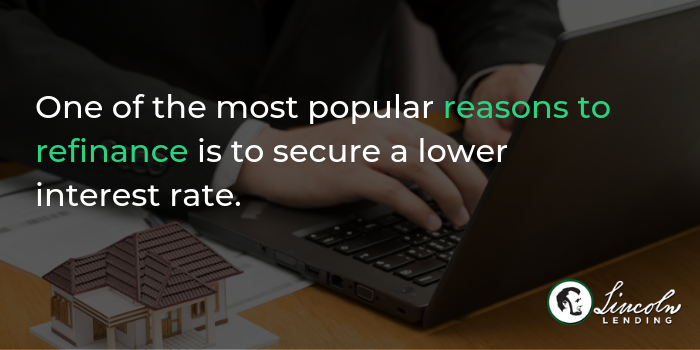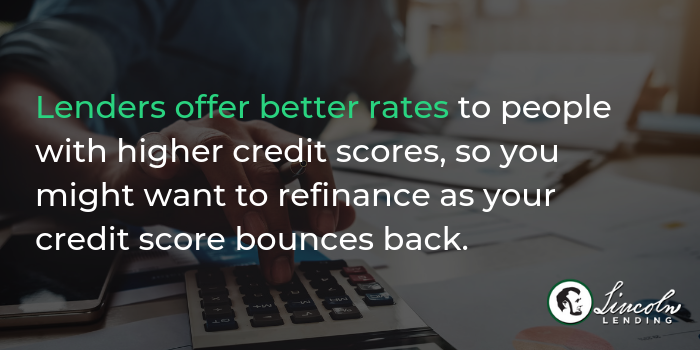For most people, their home mortgage is the single largest piece of debt that they will ever take on. A house is a valuable asset, but mortgages come with tradeoffs. Over the life of your loan, you can pay tens of thousands of dollars in interest.
As your financial circumstances change or as interest rates drop nationwide, you might wonder if refinancing your mortgage is a good idea. In this article, we’ll cover what it means to refinance, the advantages and disadvantages, and how to decide if refinancing is a good idea for you.
What Is Refinancing?
When you refinance your mortgage, you take out a new loan that pays off your current mortgage. You’re literally purchasing your home from yourself.
The primary goal of refinancing is often to save yourself money over time, so your new loan should have better terms than your old loan. Sometimes, your goal may be to refinance to get “cash out” to pay off higher interest debts or make home improvements.
The process of refinancing is relatively simple:
- Decide what your goals are. Do you want to improve your loan? Do you need money to make improvements or pay off debt?
- Shop around for a lender offering better terms than your existing loan.
- Secure a new loan to accomplish your predetermined goals.
- Make payments on your new loan until you’ve paid it off or until you refinance again.
The process is straightforward, but knowing whether it’s the right time to refinance isn’t always so clear-cut.
Benefits of Refinancing
Refinancing can be a powerful tool to save money on your mortgage.
1. Lower Interest Rate
One of the most popular reasons to refinance is to secure a lower interest rate. Throughout a 30-year loan, you can end up paying quite a bit of interest. Lowering your rate can save you a lot of money over the life of your loan.

Caution: There are up-front costs associated with refinancing. To ensure that your new interest rate savings will outweigh these costs over time, a lender can do some basic calculations to see if refinancing is going to be a good option for you. Some believe that you need to save at least 1% on the interest rate for a refinance to make sense, but that is not always the case.
Your savings will depend greatly on the size of the loan you are refinancing. For example, a ½% interest rate reduction on a $400,000 refinance will save more money overall than a 1% interest rate reduction on a $50,000 refinance. Let your lender help you calculate the savings.
2. Lower Monthly Payments
When you lower your interest rate without changing the duration of your loan, you’ll end up lowering your monthly payment. Essentially, you take out a new 30-year loan. Since your principal is lower after years of paying down your original loan, your monthly payments decrease.
For example, a person with a $100,000 loan at 5% interest would pay about $537 each month for 30 years.
A person with an $80,000 loan at 5% interest would pay about $430 each month for 30 years.
Two loans with identical terms can have very different monthly payments because of different principal balances.
If you want to free up some of your cash each month to spend on other things, this type of refinancing might be the right choice for you.
3. Shorten Your Loan Term
One way to refinance your loan is to trade in your 30-year loan for a 15-year mortgage. 15-year loans usually have lower interest rates. However, the tradeoff is usually higher monthly payments.
You could also do a “faux” refinance by making additional payments toward your 30-year loan so that you pay it off in half the time. You would save money upfront because you wouldn’t have to pay the title, insurance, or closing fees to refinance. It also gives you the flexibility to lower your monthly payments if your financial situation changes in the future. This is a good option if refinancing would not get you a low enough interest rate to offset the upfront costs.
4. Change Your Loan Type
Loans have either a variable interest rate or a fixed rate. Some people choose to refinance to change the type of rate that they have. If interest rates are low, it might be smart to refinance your variable-rate loan to a fixed-rate loan to lock in that lower interest rate.
Invariably, interest rates will rise again in time, so securing a favorable fixed-rate loan could save you quite a bit of money over time.
Downsides of Refinancing
Refinancing isn’t always the right decision. For one, it can be very time-consuming because you go through the entire loan process all over again.
You also have to pay all of the loan fees again, including title and mortgage tax. The biggest expense is paying closing costs again.
If you choose to refinance your 30-year mortgage with another 30-year loan, you should make sure that the new interest rate is significantly lower than your current rate. If it’s only slightly better, you could actually end up paying more in interest over time.
Your financial situation right now might make it necessary for you to lower your monthly payment. However, you should put more toward your principal in the future if you can to reduce your total interest payments.
How Do You Know If It’s a Good Time to Refinance?
You may have a high-interest rate loan if you had to file for bankruptcy, filed for divorce, or had a financial emergency. Lenders offer better rates to people with higher credit scores, so you might want to refinance as your credit score bounces back.
Refinancing may be smart if you have a large amount of equity in your home and you want to borrow against it for home renovations. You could get cash to pay for the updates and lower your interest rate at the same time.
Keep in mind that refinancing usually costs 3% - 6% of your current loan’s principal balance. It can take a few years for your interest savings to recoup that initial cost. If you think you will sell your home soon, you may not have time to recover those upfront costs. In that case, it might not be wise to refinance.
Every Situation is Unique
You may want to start your refinancing decision with a simple mortgage calculator. If it seems like refinancing might be a good idea for you, get in touch with our loan specialists. We can help you evaluate your refinance goals and perform some initial basic calculations without charging any fees or pulling credit.
Our initial calculations help determine whether or not the potential savings is significant enough for you to go through the refinance process. With a minimal time commitment up front, together, we can decide which refinancing opportunity, if any, is best for you.

